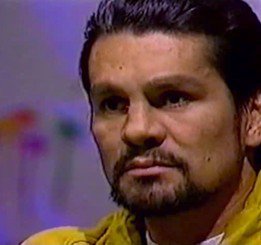Who killed JFK?
Whatever happened to Lord Lucan?
Where did Jimmy Hoffa go?
The above mysteries of history are likely to never, ever be solved and we are destined to be at the mercy of the conspiracy theorists when it comes to answers. But in the sport of boxing there are arguably two fights /events /strange endings that continue to top the list when it comes to asking, what really happened? These two fights are the Ali-Liston fights of the mid 1960s, and the second Roberto Duran-Sugar Ray Leonard fight of 1980 (okay, that’s actually three fights).
Fans across the globe have asked, and will continue to ask, if Sonny Liston took a dive, or dives, in his two bouts with Ali, but even more fans, it seems, ponder what really happened that November day of 1980 when Duran and Leonard met in their New Orleans rematch. Fans everywhere know that Duran – who had sensationally won the first fight five months earlier, winning the welterweight title and taking Sugar’s unbeaten record – inexplicably turned away from Leonard in the 8th-round of the return, waved one arm and quit, reportedly muttering the words, No Mas (no more).
But due to this act on the part of Duran, the ultimate tough guy of the sport, the theories abounded. Duran’s initial explanation was stomach cramps, brought on by losing too much weight (Roberto, a notorious party animal, ballooned to something like 200-pounds after shocking Leonard in Montreal), but he later said he quit simply because “fool” Leonard was not fighting a real fight and was, as a result of his showboating and taunting, making a fool out of the very sport both greats were representing (to say nothing of making a fool of Duran himself).
It was pompous commentator Howard Cosell who first told the world what Duran had said as he flat out quit, but years later, Duran said he never actually spoke the words – No Mas – Cosell said he heard him say. That’s an interesting sidebar to the saga, but when it comes to the crunch: why did Duran quit, we still don’t know for sure some 36 years on (come November).
Was Duran simply embarrassed at not being able to punish “Golden Boy” Leonard for his bolo punching, his showing off and for his having the temerity to tease the great Panamanian? Was there a massive, as yet undiscovered bet placed by someone, somewhere on Duran doing what he did? Was hero to millions Duran about to suffer the ultimate humiliation and soil himself live on TV in front of an audience of these millions? Did Duran have a religious experience that prevented him from ever again wanting to hurt another human being?
These theories, varying from plausible to just plain whacky, have been forwarded ever since the November, ’80 fight; these and a good deal more. Today, Duran is tight-lipped on the subject (maybe the new movie, “Hands of Stone” will reveal something new) and Leonard was, for years, frustrated at the way writers focused more on Duran’s act than on his revenge victory.
Will Duran ever tell us why he did what he did in New Orleans? Does Roberto even know why he did what he did? Maybe a mystery is a good thing, as it keeps minds fertile. The truth can often be boring; better to have a mass of fascinating, even scary theories on what happened.
This is something this fight, or rather its peculiar ending, has enjoyed for three and-a-half decades. Unless “Hands of Stone” proves to be a truly revelatory picture, this will not change any time soon. And despite the initial damage the No Mas incident inflicted on Duran’s reputation, how much bigger has his, and Sugar Ray’s, legend become because of it.
